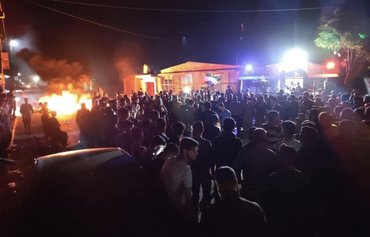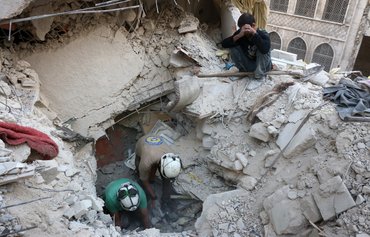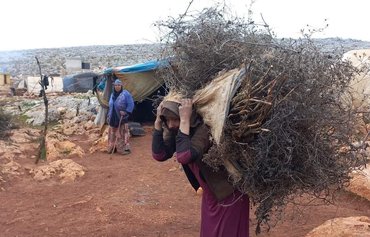The Syrian regime and its allies, including its main backer, Russia, between 2014 and 2022 engaged in a "disturbing pattern of deliberate targeting" of displacement camps in Syria, a new report reveals.
The revelation comes in a report published July 10 by the Syria Justice and Accountability Centre (SJAC), a Syrian human rights organisation that collects and analyses documentation of violations from all available sources.
The report compiles evidence that a series of attacks on four clusters of displacement camps "were neither accidental nor limited to military targets, but rather a tactic deployed by the government and its allies as a strategy of war".
It shows the Syrian regime and its allies "had prior knowledge that its targets housed civilians but were nevertheless sought out for attack" in actions that "likely amount to war crimes and crimes against humanity".
![An aerial view taken November 21, 2019, shows the charred remains of a tent following Syrian regime bombardment of al-Qah displacement camp in Idlib province. [Omar Haj Kadour/AFP]](/cnmi_am/images/2023/07/17/43042-Qah-aerial-view-600_384.jpg)
An aerial view taken November 21, 2019, shows the charred remains of a tent following Syrian regime bombardment of al-Qah displacement camp in Idlib province. [Omar Haj Kadour/AFP]
![Syrians look at a fragment of a ground-to-ground missile fired by regime forces that hit a displacement camp in the Idlib village of al-Qah on November 21, 2019. [Aaref Watad/AFP]](/cnmi_am/images/2023/07/17/43041-ground-ground-missile-600_384.jpg)
Syrians look at a fragment of a ground-to-ground missile fired by regime forces that hit a displacement camp in the Idlib village of al-Qah on November 21, 2019. [Aaref Watad/AFP]
'Pattern of civilian harm'
SJAC investigators identified and verified 17 incidents of attacks on tented camps housing internally displaced persons (IDPs) in four areas.
"Each of these camps could be clearly recognised from aerial positions, due to their distinctive layouts and characteristic, blue-coloured tents," the report said.
"In all cases but one, the suspected perpetrator was identified as the Syrian government or its allies. In some instances, multiple witnesses reported that aircraft circled the area numerous times, scouting the attack's intended target."
In each of the attacks -- on al-Naqeer (Abdeen), al-Qah and Kafr Jalis in Idlib province and Obin (Aishah) in Latakia -- SJAC was able to establish the Syrian regime and its allies had prior knowledge of the civilian nature of the camps.
But they decided to strike anyway.
"These four incidents represent a fraction of a broader pattern of civilian harm, wherein the government and its allies ruthlessly assaulted its most vulnerable populations, whom it bore the duty to protect," the report said.
Despite extensive media and humanitarian coverage following an initial attack that identified the camps as civilian, subsequent attacks occurred, SJAC said.
In some cases "a Syrian intelligence document predating the attack named and characterised the camp as civilian in nature" and/or "Russian propaganda described an attack that would later take place" as a means of deflecting blame.
While the Syrian regime attempted to associate the camps with opposition forces, "even government documents acknowledged that al-Qah IDP camp housed some relatives of opposition members, but not the fighters themselves".
"Family members who have not taken up arms are still considered civilians," SJAC noted.
"As humanitarian camps, these camps were not solely for displaced families of opposition members, but also for civilians with no relatives participating in the conflict."
Repeated attacks on camps
By repeatedly attacking the camps, the Syrian regime forced civilians to abandon their temporary homes, with al-Naqeer camp residents forced to move a few kilometres up the road to avoid being targeted.
"Despite this, the camp was attacked a third time," the report said.
"Witnesses shared with SJAC that after attacks on IDP camps, several civilians felt that the only way to avoid being killed was to leave Syria."
In 2014 and 2015, Syrian forces attacked al-Naqeer camp three times, "despite the use of scouting planes in the area to observe the camp prior to the attacks and complaints to the UN that the camps did not house combatants".
"Additionally, the reports were widely covered in media publications after the first and second attacks," the report said.
"Nevertheless, the Syrian Armed Forces continued to target IDPs in al-Naqeer camp, killing many and once again displacing countless others."
In 2015 and 2016, residents displaced to Obin (Aishah) camp after Russian cluster bombs destroyed their homes and villages were bombed repeatedly.
Syrians displaced during the Idlib offensive who fled to al-Qah to escape the heavy bombardment were targeted by a missile on the evening of November 20, 2019, killing at least 13 civilians and wounding dozens.
Twenty tents were destroyed, and a further 40 were damaged by shrapnel.
Al-Qah Maternity Hospital also was damaged.
Deceptive tactics
On November 6, newly established camps in Kafr Jalis and the neighbouring towns of Murin and Kafr Ruhin were hit with cluster munitions.
Nine Russian aircraft were observed in airspace near the incidents, with five circling, likely for surveillance, reconnaissance or target identification purposes that "should have established the widespread presence of civilians in the area".
Pro-regime media circulated videos showing footage of an attack on alleged Tahrir al-Sham "training locations and caves", with strikes on this location later determined to be 2 to 3km away from the targeted camps.
But though an attack was verified, the regime videos purporting to show the presence of militants could not be verified or geolocated -- and in any case "the civilian IDP camp was located several kilometers away and was also struck".
A day before the attack, Russian forces publicly claimed to have "received information" that al-Nusra Front (ANF) was preparing attacks in Idlib "to accuse the Syrian and Russian forces of attacking civilians and humanitarian facilities".
Yet evidence demonstrates clear Russian involvement in the attack.
"Given that Russian authorities publicly reported that an attack would occur in the civilian camps and that the only parties to the conflict known to operate the weapon used in the attack are Syria, Russia and Iran, it is highly unlikely that such an attack could have occurred without direct assistance from Syrian military forces or those of its allies if not directly executed themselves."
"The presence of scouting planes and the announcement make it evident that the strikes were a premeditated attack on known civilian targets," SJAC said.

![A Syrian boy holds a rose inside a charred tent following Syrian regime bombardment on a makeshift camp in the Idlib province village of al-Qah on November 21, 2019. [Aaref Watad/AFP]](/cnmi_am/images/2023/07/17/43040-Qah-tent-boy-600_384.jpg)






